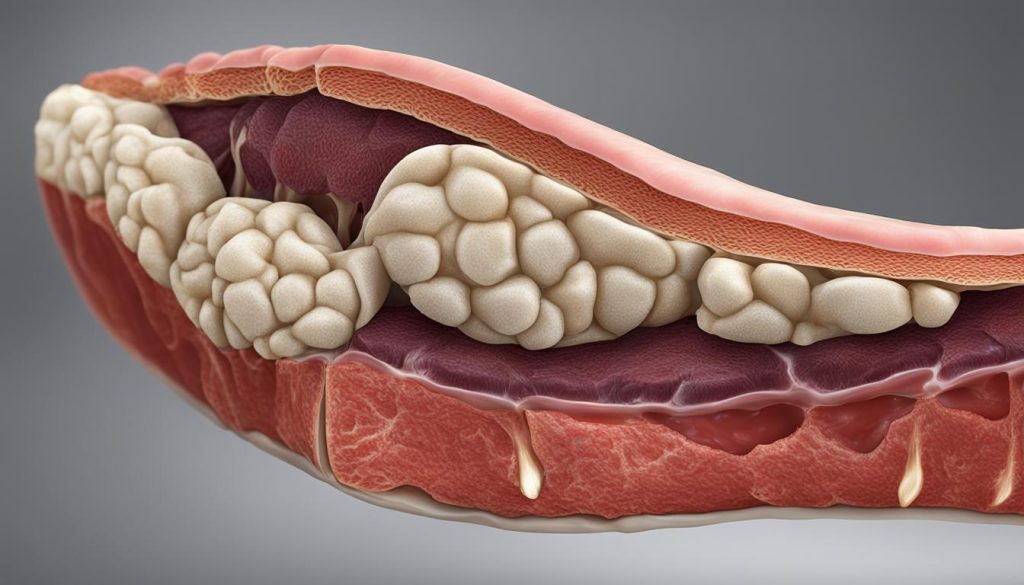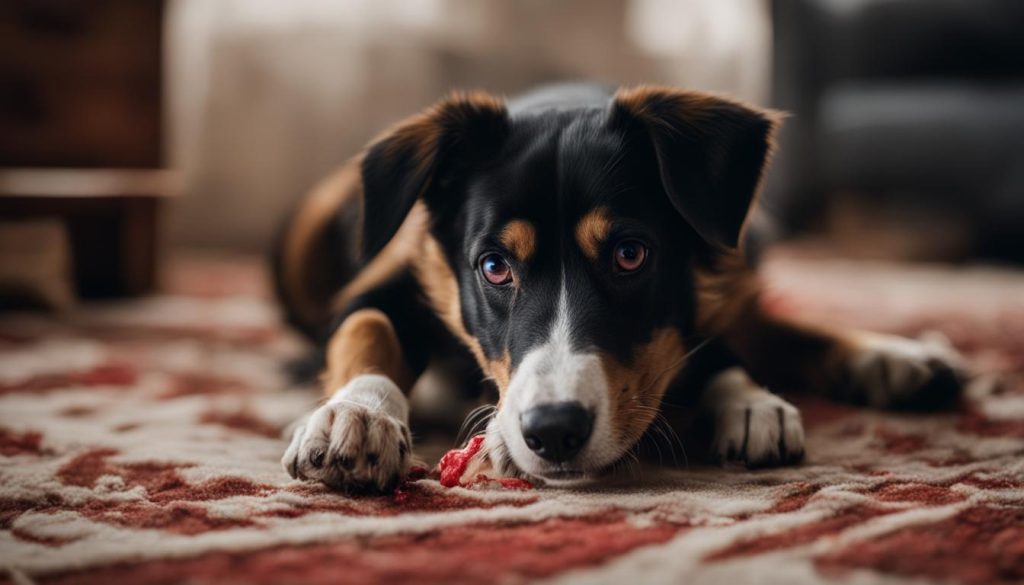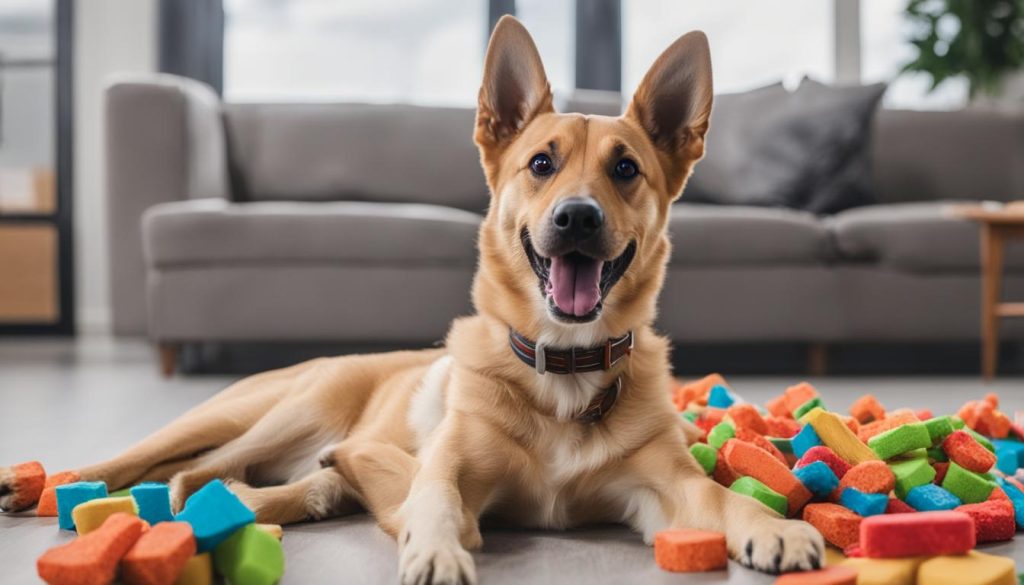Dogs biting or chewing their nails and paws can be a perplexing behavior for pet owners. Understanding the reasons behind this behavior is crucial to provide appropriate care and relief for your furry friend.
There are several common causes for dogs biting or chewing their nails and paws. These include medical issues such as yeast infections, pruritic pododermatitis, toenail, and foot problems, as well as behavioral issues. By identifying the underlying cause, we can take the necessary steps to address and manage the behavior effectively.
Key Takeaways:
- Dogs may bite or chew their nails and paws due to various reasons
- Possible causes include medical issues and behavior problems
- Identifying and addressing the underlying cause is essential for providing relief
- Regular veterinary check-ups are recommended to ensure proper diagnosis and treatment
- Preventative measures and behavioral modifications can help manage paw chewing behavior
Yeast Infection and Paw Chewing
Yeast infections can be a common cause of dogs excessively chewing and licking their paws. One of the primary culprits behind these infections is a yeast species called Malassezia pachydermatis which naturally occurs on dogs’ skin. However, when there is an overgrowth of this yeast, it can lead to intense itching and discomfort, prompting dogs to chew their paws to find relief.
The warm and moist environment between a dog’s toes provides the perfect conditions for Malassezia pachydermatis to thrive and multiply rapidly. As the yeast multiplies, it irritates the surrounding skin, causing intense itching and redness. Dogs may exacerbate the itching by biting and chewing at the affected areas, leading to further irritation and potential injury.
To address yeast infections, it is good practice to consult with a veterinarian for proper diagnosis and treatment. A veterinarian may prescribe antifungal medications or recommend topical treatments to reduce the overgrowth of yeast and alleviate itching. Additionally, maintaining good paw hygiene by regularly cleaning and drying your dog’s paws can help prevent yeast infections and reduce the urge to chew.

| Common Signs of Yeast Infection in Dogs |
|---|
| Excessive licking and chewing of paws |
| Redness and swelling between the toes |
| A distinct yeasty odor |
| Crusty or flaky skin |
| Thickened and discolored nails |
You should address yeast infections promptly to provide relief for your dog and prevent further complications. By identifying and addressing the underlying cause of the infection, you can help your furry friend find comfort and maintain healthy paws.
Pruritic Pododermatitis and Paw Chewing
Pruritic pododermatitis is a condition that causes itchy feet in dogs. It encompasses a range of underlying causes, including parasites, contact allergies, food allergies, and inhaled allergens. Identifying the specific cause is crucial for effective treatment and relief for your dog.
Parasites such as mites and hookworms can cause itching and discomfort in a dog’s paws, leading to excessive chewing and licking. Regularly checking your dog for these parasites and administering appropriate treatment can help alleviate the symptoms.
Contact allergies occur when the dog’s paw comes into contact with an irritant, such as certain chemicals or surfaces. Food allergies can also manifest as itchy feet, especially if the dog is sensitive to certain ingredients. Inhaled allergens, such as pollen or dust mites, can trigger an allergic reaction that affects the paws. Consulting with a veterinarian can help identify and manage these allergens.
Allergy Types Causing Pruritic Pododermatitis
Pruritic pododermatitis can be caused by multiple types of allergies:
- Contact Allergies: Irritants that come into direct contact with the paws.
- Food Allergies: Sensitivity to specific ingredients in the dog’s diet.
- Inhaled Allergens: Allergens that are breathed in and trigger a reaction.
| Allergen | Symptoms |
|---|---|
| Contact Allergies | Redness, swelling, itching, blisters |
| Food Allergies | Itching, inflammation, gastrointestinal issues |
| Inhaled Allergens | Sneezing, itching, watery eyes, paw licking |
Addressing pruritic pododermatitis requires a comprehensive approach. In addition to identifying and treating the underlying cause, your veterinarian may recommend topical treatments, antihistamines, or other medications to alleviate itching and soothe your dog’s paws. It’s also important to ensure regular foot hygiene and keep the paws clean and dry to prevent further irritation.
By understanding the different causes of pruritic pododermatitis, you can take proactive steps to provide relief for your dog and improve their overall well-being.

Toenail and Foot Issues
Dogs biting or chewing their nails and paws may also be indicative of toenail and foot issues. Nails that are too long can cause discomfort and prompt dogs to bite at their feet. Additionally, broken nails, whether from disease or injury, can lead to excessive licking and chewing. You might want to monitor your dog’s nails and ensure they are trimmed or ground regularly to prevent discomfort and potential complications.
Furthermore, you should check for foxtails or other grass awns between the toes and pads. These can cause irritation and discomfort, leading to excessive chewing and licking. Foxtails and grass awns can become lodged in the skin, causing pain and inflammation. Regularly inspecting your dog’s feet and removing any foreign objects will help prevent discomfort and reduce the urge to chew.
| Common Toenail and Foot Issues | Symptoms |
|---|---|
| Long dog nails | Discomfort from long nails, difficulty walking or running |
| Broken nails | Limping, bleeding, pain |
| Foxtails and grass awns | Excessive licking and chewing, redness, swelling, pain |
By addressing toenail and foot issues, you can alleviate your dog’s discomfort and reduce their urge to chew on their paws. Regular nail trimming, checking for foreign objects, and seeking veterinary care for broken nails or embedded foxtails are essential steps to ensuring your dog’s paw health and preventing further complications.
Behavior Issues and Paw Chewing
Dogs may develop behavior issues that lead to excessive licking and chewing of their paws. This behavior can become a habit, causing the dog to continue chewing even after any initial discomfort or irritation has been resolved. I recommend that you understand the underlying causes of this behavior and address them appropriately to provide relief for your dog.
One possible reason for excessive paw chewing is attention-seeking behavior. Dogs are social animals and may learn that chewing on their paws gets them attention from their owners. If they receive attention, even negative attention, when they engage in this behavior, they may continue to do so as a way to elicit a response from their owner.
Another potential cause is habit formation. Dogs are creatures of routine and may develop habits such as excessive paw chewing. Once a habit is formed, it can be challenging to break. I recommend that you provide your dog with alternative activities and outlets for their energy and attention to help redirect their focus away from their paws.
I highly suggest that you address the underlying cause of behavior issues and provide appropriate intervention. Engaging in positive reinforcement training and providing mental stimulation through interactive toys and puzzles can help redirect your dog’s behavior away from paw chewing and towards more appropriate activities. Consulting with a professional dog trainer or behaviorist can also be beneficial in addressing behavior issues and finding solutions tailored to your dog’s specific needs.
Signs of Discomfort in Paw Chewing
When dogs bite or chew their paws, it can be a sign of discomfort or underlying issues. It’s important for pet owners to be aware of the signs that indicate possible discomfort in their dogs. These signs may include:
- Paw biting
- Redness
- Swelling
- Limping
- Bleeding
- Pain
If you notice any of these signs in your dog, please take action and seek veterinary assistance. These symptoms could indicate a variety of conditions such as infections, allergies, or injuries that require prompt attention and appropriate treatment.
Understanding the signs of discomfort in dogs can help pet owners identify when their furry friends are in distress and need assistance. Regularly inspecting your dog’s paws for any abnormalities or changes can aid in early detection and intervention. When in doubt, it’s always best to consult with a veterinarian who can provide expert guidance and diagnose the underlying cause of the discomfort.
Paying attention to signs of discomfort in paw chewing can lead to a quicker resolution and provide relief for your beloved pet. To put it simply, your dog relies on you to be their advocate and ensure their well-being. By taking action and addressing their discomfort, you can help them lead a happier and healthier life.

Managing Excessive Paw Chewing
If your dog is constantly chewing on their paws, there are several steps you can take to manage this behavior and provide them with alternative activities. Excessive paw chewing can be caused by boredom and anxiety, so ensure your dog is getting enough exercise and mental stimulation.
One way to combat boredom is by providing your dog with interactive toys and puzzles that can keep them occupied and mentally engaged. These toys can help redirect their focus away from their paws and onto a more constructive activity. Additionally, regular training sessions can help stimulate your dog’s mind and provide them with the mental exercise they need.
Incorporating physical exercise into your dog’s daily routine is also crucial. Take your dog on regular walks or provide them with opportunities for play and exercise in a safe and supervised environment. This physical activity can help tire them out and reduce their overall levels of anxiety and boredom.
Furthermore, address any underlying issues that may be contributing to your dog’s paw chewing behavior. If you suspect that your dog’s paw chewing is related to a medical issue or allergies, consult with your veterinarian for proper diagnosis and treatment options.
| Managing Excessive Paw Chewing | Effective Strategies |
|---|---|
| Provide alternative activities | Use interactive toys and puzzles to redirect your dog’s focus away from their paws. |
| Address boredom and anxiety | Ensure your dog receives sufficient exercise and mental stimulation to combat these underlying causes. |
| Engage in regular training sessions | Training your dog can provide mental exercise and redirect their attention away from paw chewing. |
| Incorporate physical exercise | Take your dog on walks and provide opportunities for play and exercise to reduce anxiety and boredom. |
| Consult a veterinarian | If there are no improvements or if you suspect a medical issue, seek professional guidance from a veterinarian. |
By implementing these strategies and addressing any underlying issues, you can effectively manage your dog’s excessive paw chewing behavior and provide them with a more fulfilling and enjoyable life.

Solutions for Paw Chewing
If your dog is biting or chewing their nails and paws, there are several solutions you can try to address this behavior and provide relief for your furry friend. Here are some prevention tips for dog nail biting, soothing your dog’s paws, medical treatment options, and behavioral modification techniques that may help:
Prevention Tips for Dog Nail Biting
- Regular Nail Trimming: Keeping your dog’s nails trimmed can prevent discomfort and reduce the urge for them to bite or chew their paws. If you are unsure how to trim your dog’s nails safely, consult a professional groomer or your veterinarian.
- Proper Foot Care: Regularly inspect your dog’s paws for any signs of injury, irritation, or foreign objects like foxtails. Clean their paws thoroughly after walks to remove any potential allergens or irritants.
Soothing Your Dog’s Paws
- Warm Water Soaks: Soaking your dog’s paws in warm water with Epsom salt can help relieve itching and reduce inflammation. Make sure the water is not too hot and gently dry their paws afterward.
- Natural Remedies: There are various natural remedies available, such as oatmeal-based shampoos or balms that can provide soothing relief for your dog’s paws. Consult with your veterinarian for recommendations.
Medical Treatment Options
- Medications: In cases where the paw chewing is caused by an underlying medical condition like allergies or infections, your veterinarian may prescribe medications to alleviate discomfort and reduce the urge to chew.
- Allergy Testing and Immunotherapy: If allergies are suspected, allergy testing can help identify specific triggers. Immunotherapy, such as allergy shots or oral drops, can be effective in managing allergic reactions and reducing paw chewing.
Behavioral Modification
- Positive Reinforcement: Rewarding your dog for good behavior and providing alternative activities can help redirect their focus away from paw chewing. Engage them in interactive play, provide mental stimulation through puzzles, and offer chew toys to keep their mouths occupied.
- Training and Enrichment: Enroll your dog in obedience training classes to teach them alternative behaviors and commands. Increase their physical exercise to alleviate boredom and anxiety, which can contribute to excessive paw chewing.
To put it simply, consult with your veterinarian to determine the underlying cause of your dog’s paw chewing and develop a comprehensive treatment plan. By addressing both the physical and behavioral aspects, you can help your furry companion find relief and break the habit of paw chewing.
| Solution | Description |
|---|---|
| Prevention Tips for Dog Nail Biting | Regular nail trimming and proper foot care can prevent discomfort and reduce the urge to chew paws. |
| Soothing Your Dog’s Paws | Warm water soaks and natural remedies like oatmeal-based shampoos can provide relief for itchy paws. |
| Medical Treatment Options | Medications and allergy testing with immunotherapy can alleviate discomfort and manage underlying conditions. |
| Behavioral Modification | Positive reinforcement, training, and enrichment activities help redirect focus away from paw chewing. |

Final Thoughts
To sum it up, if your dog is biting or chewing their nails and paws, please identify the underlying cause and provide appropriate solutions. Some common reasons for this behavior include medical issues, behavior problems, and boredom. By addressing these factors, you can provide relief for your dog and help prevent further discomfort.
If the paw chewing persists or is causing concern, it is highly recommended to book a visit with a veterinarian. A professional evaluation can help determine the exact cause of the behavior and guide you towards the most effective treatment options. Whether it’s a medical issue that requires medication or a behavioral problem that needs modification, your vet will be able to provide the necessary guidance and support.
To put it simply, providing relief for your dog is essential for their overall well-being. By taking proactive measures, such as regular nail trimming, proper foot care, and addressing potential health issues, you can help reduce the likelihood of nail and paw chewing. Additionally, providing alternative activities, sufficient exercise, and mental stimulation can help redirect their focus away from their paws and towards more appropriate behaviors.
By addressing the root causes of nail and paw chewing and working closely with your vet, you can ensure your dog’s comfort and help them lead a happy and healthy life. So, if you notice your dog biting or chewing their nails and paws, take action and provide the necessary relief they need.
FAQ
Why do dogs bite or chew their nails and paws?
Dogs may bite or chew their nails and paws for various reasons, including medical issues, behavior problems, and boredom.
What are some common causes of paw chewing in dogs?
Common causes of paw chewing in dogs include yeast infections, pruritic pododermatitis, toenail and foot issues, and behavior issues.
Can yeast infections cause dogs to chew their paws?
Yes, yeast infections can cause dogs to excessively lick and bite at their feet. The overgrowth of yeast can make the surrounding skin incredibly itchy, leading to paw chewing.
What is pruritic pododermatitis?
Pruritic pododermatitis is a diagnosis that encompasses itchy feet with various causes, including parasites, allergies, and other irritants.
Can long nails cause dogs to chew their paws?
Yes, nails that are too long can cause discomfort and prompt dogs to bite at their feet. Broken nails can also lead to excessive licking and chewing.
Are behavior issues a possible cause of paw chewing?
Yes, behavior issues can be a cause of excessive licking and chewing that persists even after the initial cause has been resolved. Addressing the underlying cause and providing alternative activities can help redirect your dog’s focus away from their paws.
What are the signs of discomfort in dogs that are biting or chewing their paws?
Signs of discomfort in dogs that are biting or chewing their paws may include redness, swelling, limping, bleeding, and visible signs of pain.
How can I manage excessive paw chewing in my dog?
Proactive measures can be taken to provide alternative activities for your dog, such as regular exercise, mental stimulation, and the use of toys and puzzles. Additionally, addressing any underlying medical or behavioral issues may help reduce paw chewing.
What are some solutions for dogs that bite or chew their nails and paws?
Solutions for dogs that bite or chew their nails and paws include prevention tips such as regular nail trimming, providing proper foot care, and addressing potential underlying health issues. Medical treatment options may involve medications to alleviate discomfort or manage allergies. Behavioral modification techniques can also be helpful in redirecting your dog’s behavior away from paw chewing.
When should I book a veterinarian visit for my dog’s paw chewing?
If the paw chewing persists or is causing concern, please consult a veterinarian for further evaluation and treatment. A vet can help identify any underlying medical conditions and provide appropriate care for your dog.






